AUDI A5 COUPE 2012 Owners Manual
Manufacturer: AUDI, Model Year: 2012, Model line: A5 COUPE, Model: AUDI A5 COUPE 2012Pages: 316, PDF Size: 78.59 MB
Page 191 of 316
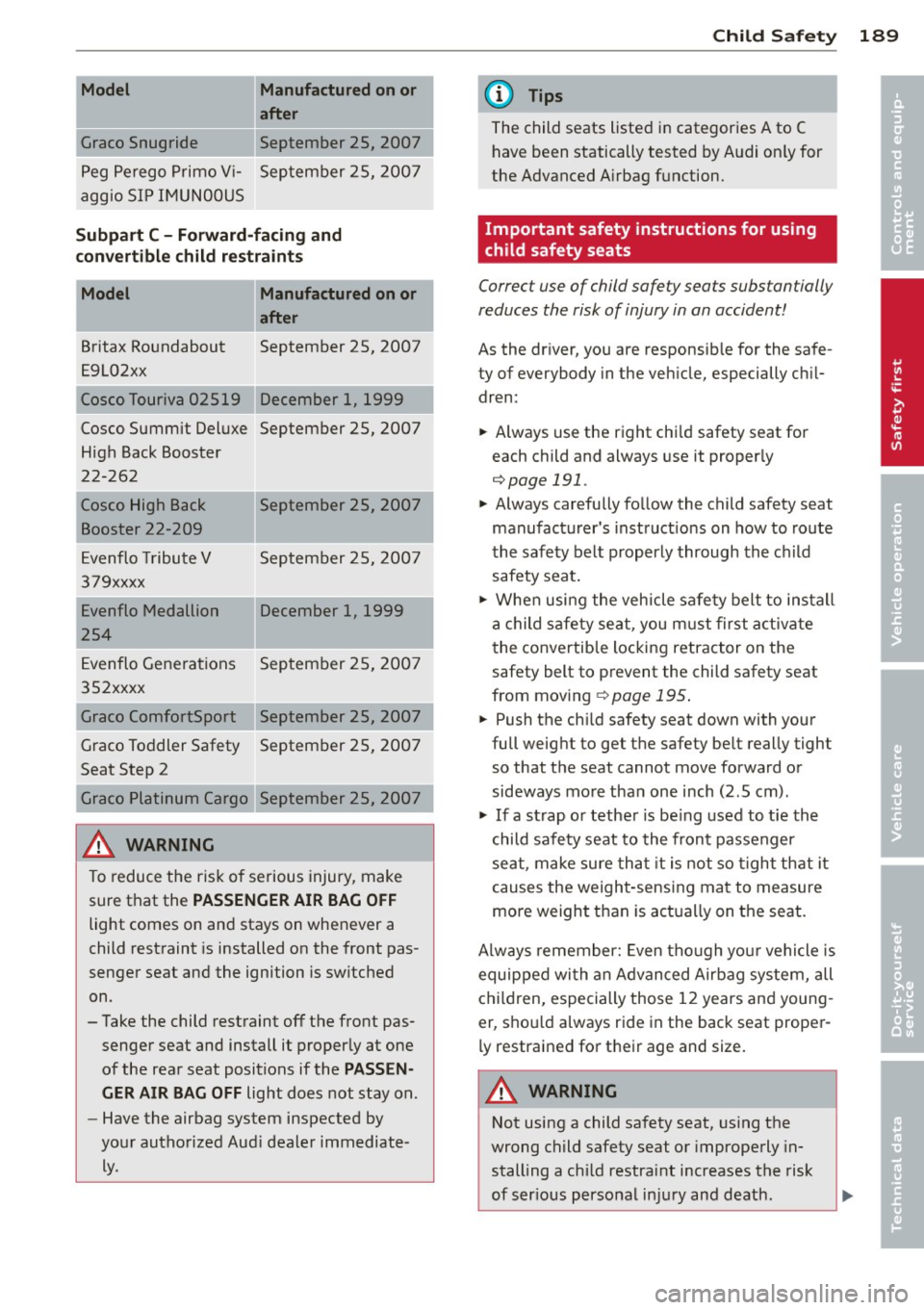
-Model Manufactured on or
after
Graco Snugride September 25, 2007
Peg Perego Primo V i- September 25, 200 7
aggio SIP I MUN00US
Subpart C -Forward-facing and
con vertible child r estra ints
Model Manufactured on or
after
Britax Roundabout September 25, 2007
E9L02xx
Cosco Touriva 02519 December 1, 1999
Cosco Summit Deluxe September 25, 2007
High Back Booster
22-262
Cosco High Back September 25, 2007
Booster 22-209
Evenflo Tribute V September 25, 2007
379xxxx
Evenflo Medallion December 1, 1999
254
Evenflo Generations September 25, 200 7
352xxxx
Graco ComfortSport September 25, 2007
Graco Toddler Safety September 25, 2007
Seat Step 2
Graco Platinum Cargo September 25, 2007
A WARNING
T o reduce the risk of serious injury, make
sure that the
PASSENGER AIR BAG O FF
light comes on and stays on whenever a
child restraint is installed on the front pas
senger seat and the ignition is switched
on.
- Take the child restraint off the fro nt pas
senger seat and install it properly at one of the rea r seat positions if the
PASSEN
GER AIR BAG OFF
light does not stay on.
- Have the airbag system inspected by
your authorized Aud i dealer immediate
ly.
Child Sa fet y 189
(D Tips
The child seats listed in categories A to C
have been statically tested by A udi on ly for
the Advanced A irbag function.
Important safety instructions for using
child safety seats
Correct use of child safety seats substantially
reduces the risk of injury in an accident!
As the dr iver, you are responsible for the safe
ty of everybody in the vehicle, especially ch il
dren:
... Always use the right chi ld safety seat for
each child and always use it properly
¢page 191 .
... Always carefully fo llow the child safety seat
manufacturer's instruct ions on how to route
the safety belt properly through the child
safety seat.
... When usi ng the veh icle safety belt to ins tall
a child safety se at, you m ust first activate
the convertib le locking retractor on the
safety belt to prevent the child safety seat
from moving
¢ page 195.
... Push the ch ild safety seat down with your
full weight to get the safety be lt really tight
so that the seat cannot move forwa rd or
sideways mo re than one inch (2.5 cm) .
... If a strap o r tethe r is be ing used to tie the
child safety seat to the front passenger
s eat, make sure tha t it is not so tight that it
causes the weight-sensing mat to measure
more weight than is act ually on the seat.
A lways remember: Even tho ugh yo ur vehicle is
equippe d wi th an Advanced Airbag system, all
c h ildren, especially those 12 years and young
er, shou ld always ride in the back seat prope r
l y restrained for their age and size.
A WARNING
Not using a child safety seat, using the
wrong child safety seat o r improperly in
stalling a ch ild restraint increases the risk
of ser ious personal inj ury and death.
-
•
•
Page 192 of 316
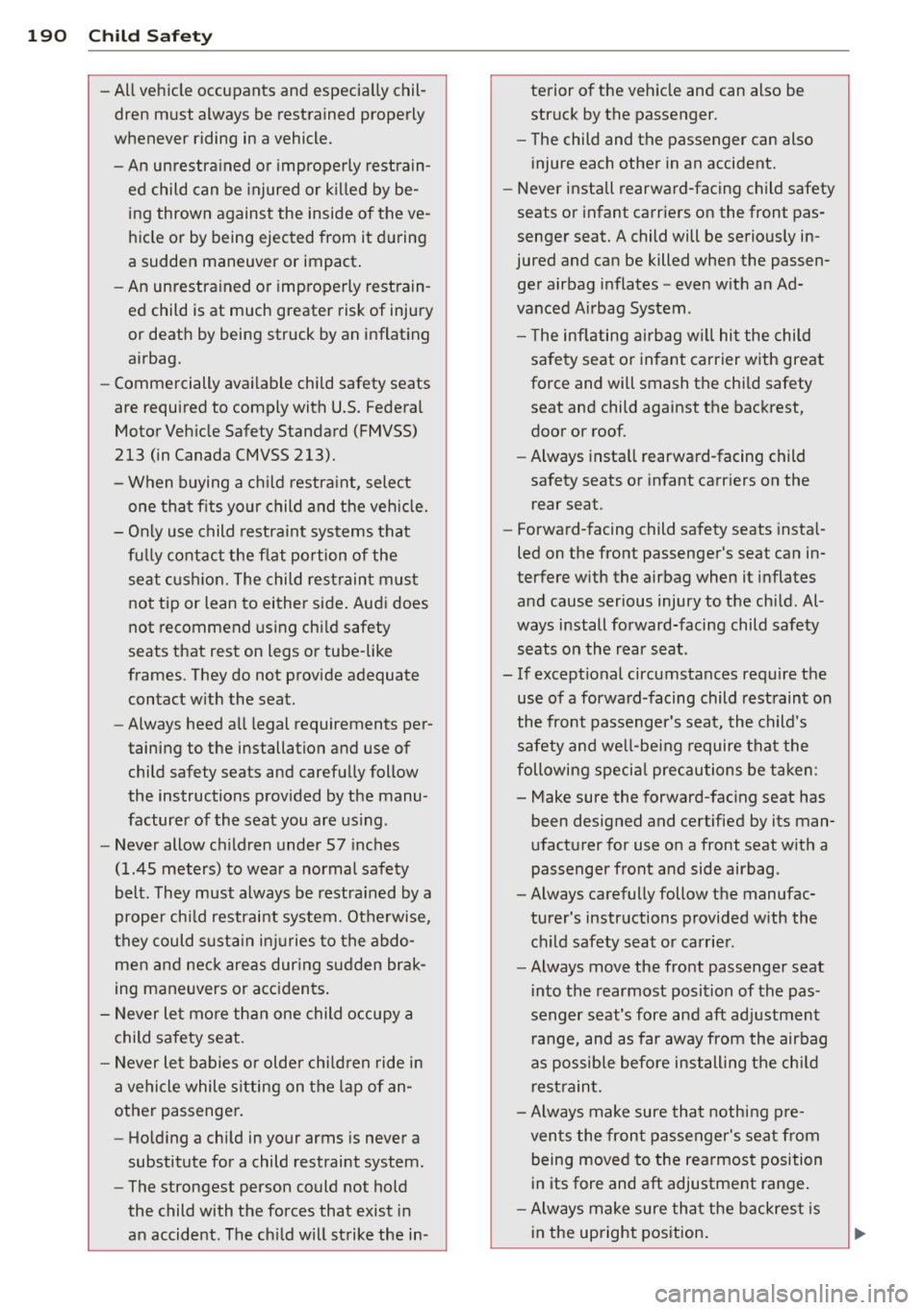
190 Child Safety
-All vehicle occupants and especially chil
dren must always be restrained properly
whenever riding in a vehicle.
- An unrestrained or improperly restrain
ed child can be injured or killed by be
ing thrown against the inside of the ve
hicle or by being ejected from it during
a sudden maneuver or impact.
- An unrestrained or improperly restrain
ed child is at much greater risk of injury
or death by being struck by an inflating
airbag.
- Commercially available child safety seats
are required to comply with U.S. Federal
Motor Vehicle Safety Standard (FMVSS)
213 (in Canada CMVSS 213).
- When buying a child restraint, select
one that fits your child and the vehicle.
- Only use child restraint systems that
fully contact the flat portion of the
seat cushion. The child restraint must not tip or lean to either side. Audi does
not recommend using child safety
seats that rest on legs or tube-like
frames. They do not provide adequate
contact with the seat.
- Always heed all legal requirements per
taining to the installation and use of
child safety seats and carefully follow
the instructions provided by the manu
facturer of the seat you are using .
- Never allow children under 57 inches
(1.45 meters) to wear a normal safety
belt. They must always be restrained by a
proper child restraint system. Otherwise,
they could sustain injuries to the abdo
men and neck areas during sudden brak
ing maneuvers or accidents.
- Never let more than one child occupy a
child safety seat.
- Never let babies or older children ride in
a vehicle while sitting on the lap of an
other passenger.
- Holding a child in your arms is never a
substitute for a child restraint system.
- The strongest person could not hold
the child with the forces that exist in
an accident . The child will strike the in- terior of the vehicle and can also be
struck by the passenger.
- The child and the passenger can also
injure each other in an accident.
- Never install rearward-facing child safety
seats or infant carriers on the front pas
senger seat. A child will be seriously in
jured and can be killed when the passen
ger airbag inflates -even with an Ad
vanced Airbag System .
- The inflating airbag will hit the child
safety seat or infant carrier with great
force and will smash the child safety
seat and child against the backrest,
door or roof.
- Always install rearward-facing child
safety seats or infant carriers on the
rear seat .
- Forward-facing child safety seats instal
led on the front passenger's seat can in
terfere with the airbag when it inflates
and cause serious injury to the child. Al
ways install forward-facing child safety
seats on the rear seat .
-If exceptional circumstances require the
use of a forward-facing child restraint on
the front passenger's seat, the child's
safety and well-being require that the
following special precautions be taken :
- Make sure the forward-facing seat has been designed and certified by its man
ufacturer for use on a front seat with a
passenger front and side airbag .
- Always carefully follow the manufac
turer's instructions provided with the
child safety seat or carrier.
- Always move the front passenger seat
into the rearmost position of the pas
senger seat's fore and aft adjustment
range, and as far away from the airbag
as possible before installing the child restraint.
- Always make sure that nothing pre
vents the front passenger's seat from being moved to the rearmost position
in its fore and aft adjustment range.
- Always make sure that the backrest is
in the upright position.
Page 193 of 316
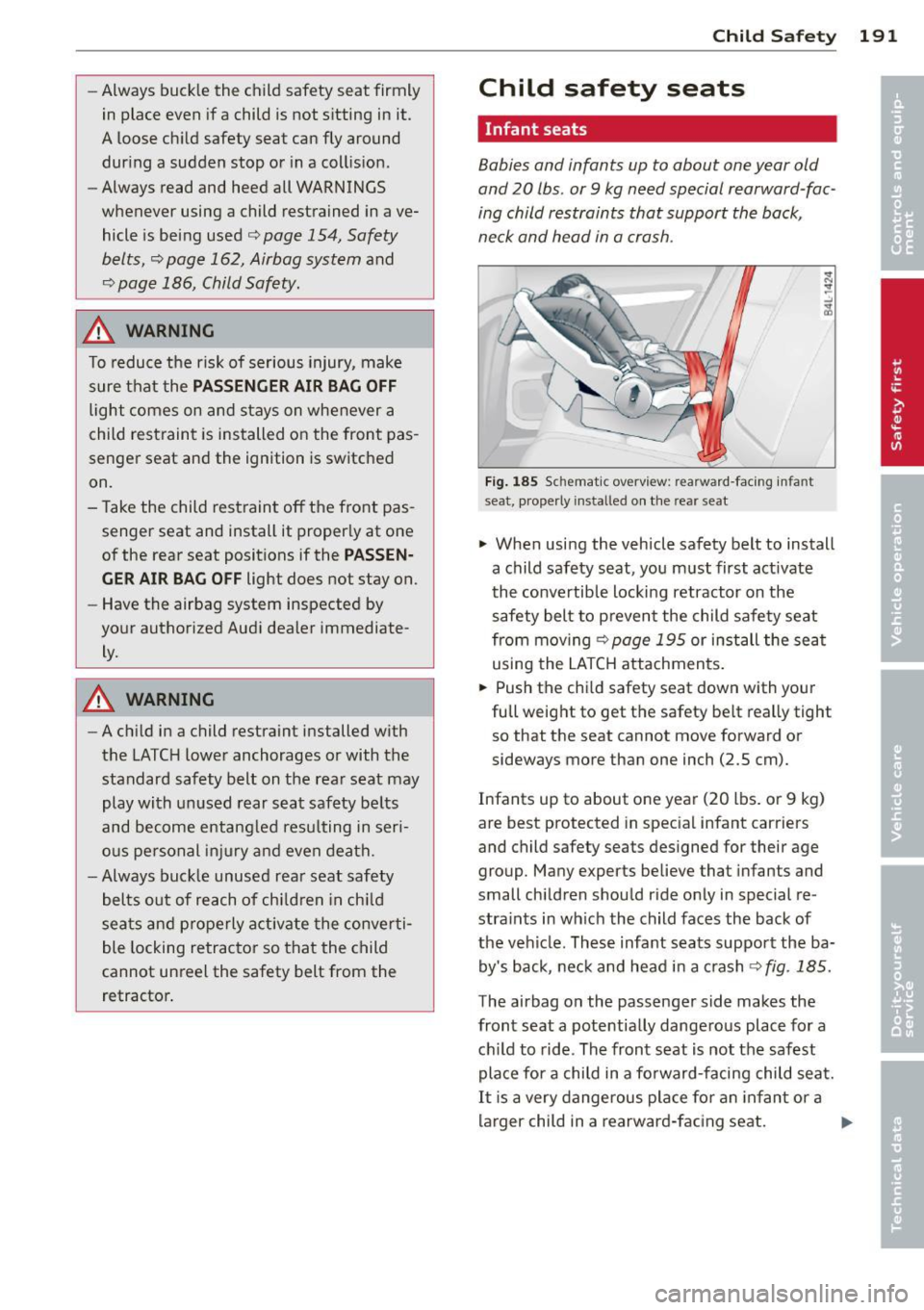
-Always buck le the child safety seat firmly
in place even if a child is not s itting in it.
A loose ch ild safety seat can fly around
dur ing a sudden stop or in a col lision .
- Always read and heed all WARNINGS
whenever using a child restrained in ave
hicle is being used
<=> page 154, Safety
belts,
<=) page 162, Airbag system and
¢ page 186, Child Safety.
A WARNING
To reduce the risk of serious injury, make
sure that the
PA SSENGER AIR BAG OFF
light comes on and stays on whe never a
child restraint is installed on the front pas
senger seat and the ignition is switched
on.
- Take the child restraint off t he fro nt pas
senger seat and install it proper ly at one
of the rear seat positions if the
PASSEN
G ER AIR BAG OFF
light does not stay on.
- Have the airbag system inspected by
your authorized Aud i dealer immediate
ly.
A WARNING
- A child in a child restraint installed with
the LATCH lowe r anchorages or with the
standard safety belt on the rear seat may
play with unused rear seat safety be lts
and become entang led resu lting in ser i
o us personal injury and even death.
- Always buck le unused rear seat safety
bel ts out of reach of chi ld ren in ch ild
sea ts and p roperly activ ate the converti
ble locking retracto r so that the child
cannot unreel the safety belt from the
retractor .
.
Child S afety 191
Child safety seats
Infant seats
Babies and infants up to about one year old
and 20 lbs. or 9 kg need special rearward -fac
ing child restraints that support the back,
neck and head in a crash .
Fig. 185 Schem atic ove rvi ew : re arward-fac ing in fant
se at, p rope rly insta lled on the re ar seat
.. When using the vehicle safety belt to install
a child safety seat, you must first activate
the convertib le locking retractor on the
safety belt to prevent the child safety seat
from mov ing
c> page 195 or install the seat
using the LATCH attachments .
.. Push the chi ld safety seat down w ith your
full weight to get the safety be lt really tight
so that the seat cannot move forward or
sideways more than one inch (2.5 cm).
Infants up to about one year (20 lbs. or 9 kg)
are best protected in special infant carriers
and child safety sea ts designed for their age
group. Many experts believe that infan ts and
small children should r ide only in special re
stra ints in wh ich the child faces the back of
the vehicle. These infant seats support the ba
by 's back, neck and head in a crash ¢
fig. 185.
The airbag on the passenger side makes the
front seat a potentially dangerous place for a
ch ild to ride . The front seat is not the safest
place for a child in a forward-facing child seat.
It is a very dangerous place fo r an in fant or a
larger child in a rearward-facing seat. .._
Page 194 of 316
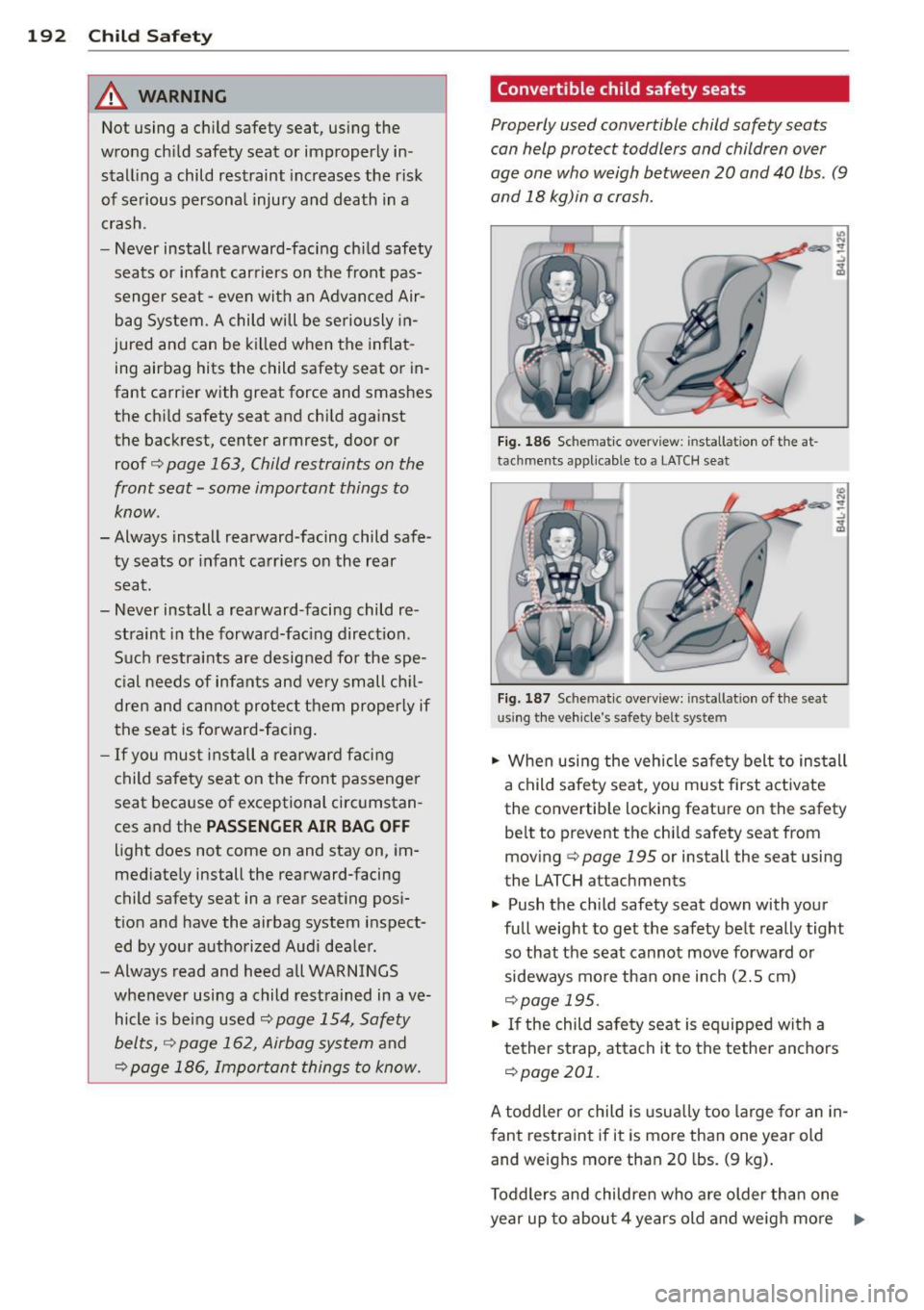
192 Child Safety
& WARNING
Not using a child safety seat, using the
wrong child safety seat or improperly in
stalling a child restraint increases the risk of serious personal injury and death in a
crash.
- Never install rearward-facing child safety
seats or infant carriers on the front pas
senger seat - even with an Advanced Air
bag System. A child will be seriously in
jured and can be killed when the inflat
ing airbag hits the child safety seat or in
fant carrier with great force and smashes
the child safety seat and child against
the backrest, center armrest, door or
roof
c:> page 163, Child restraints on the
front seat -some important things to
know.
- Always install rearward-facing child safe
ty seats or infant carriers on the rear
seat.
- Never install a rearward-facing child re straint in the forward-facing direction. Such restraints are designed for the spe
cial needs of infants and very small chil
dren and cannot protect them properly if
the seat is forward-facing.
- If you must install a rearward facing
child safety seat on the front passenger
seat because of exceptional circumstan
ces and the
PASSENGER AIR BAG OFF
light does not come on and stay on, im
mediately install the rearward-facing
child safety seat in a rear seating posi
tion and have the airbag system inspect
ed by your authorized Audi dealer.
- Always read and heed all WARNINGS
whenever using a child restrained in ave
hicle is being used
c:>page 154, Safety
belts,
c:> page 162, Airbag system and
c:> page 186, Important things to know.
Convertible child safety seats
Properly used convertible child safety seats
can help protect toddlers and children over
age one who weigh between 20 and
40 lbs. (9
and 18 kg)in a crash.
Fig. 186 Schematic overview: installat ion of t he at
tachments appl icable to a LATCH seat
Fig. 187 Schematic overview: installat ion of the seat
using the vehicl e's safety belt system
.,. When using the vehicle safety belt to install
a child safety seat, you must first activate
the convertible locking feature on the safety
belt to prevent the child safety seat from
moving
c:> page 195 or install the seat using
the LATCH attachments
., Push the ch ild safety seat down with your
full weight to get the safety belt really tight
so that the seat cannot move forward or
sideways more than one inch (2.5 cm)
c:> page 195 .
.,. If the child safety seat is equipped with a
t ether strap, attach it to the tether anchors
c:>page 201.
A toddler or child is usually too large for an in
fant r estraint if it is more than one year old
and weighs more than 20 lbs. (9 kg) .
Toddlers and children who are older than one
year up to about 4 years old and weigh more ..,.
Page 195 of 316
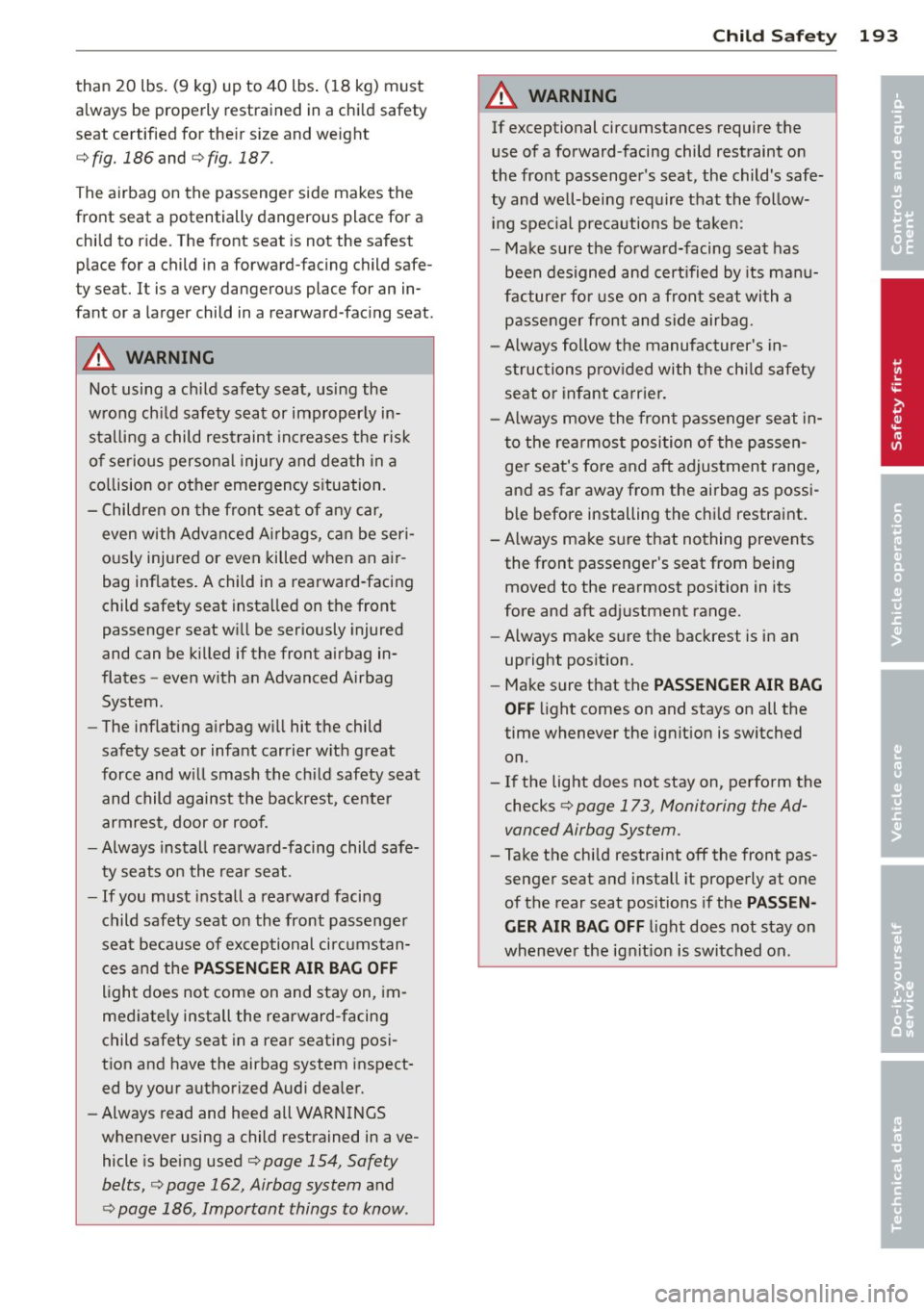
than 20 lbs. (9 kg) up to 40 lbs. (18 kg) must
always be properly restrained in a child safety
seat certified for their size and weight
¢
fig. 186 and¢ fig. 187.
The airbag on the passenger side makes the
front seat a potentially dangerous place for a
child to ride. The front seat is not the safest
place for a child in a forward-facing child safe
ty seat.
It is a very dangerous place for an in
fant or a larger child in a rearward -facing seat .
_A WARNING
Not using a child safety seat, using the
wrong child safety seat or improperly in
stalling a child restraint increases the risk
of serious personal injury and death in a
collision or other emergency situation.
- Children on the front seat of any car,
even with Advanced Airbags, can be seri
ously injured or even killed when an air
bag inflates. A child in a rearward-facing
child safety seat installed on the front
passenger seat will be seriously injured
and can be killed if the front airbag in
flates -even with an Advanced Airbag
System.
- The inflating airbag will hit the child
safety seat or infant carrier with great
force and will smash the child safety seat
and child against the backrest, center
armrest, door or roof.
- Always install rearward-facing child safe
ty seats on the rear seat .
-If you must install a rearward facing
child safety seat on the front passenger
seat because of exceptional circumstan
ces and the
PASSENGER AIR BAG OFF
light does not come on and stay on, im
mediately install the rearward-facing
child safety seat in a rear seating posi
tion and have the airbag system inspect
ed by your authorized Audi dealer.
- Always read and heed all WARNINGS
whenever using a child restrained in ave
hicle is being used¢
page 154, Safety
belts,¢ page 162, Airbag system
and
¢ page 186, Important things to know.
Child Safety 193
_A WARNING
If exceptional circumstances require the
use of a forward-facing child restraint on
the front passenger's seat, the child's safe
ty and well-being require that the follow
ing special precautions be taken:
- Make sure the forward-facing seat has
been designed and certified by its manu
facturer for use on a front seat with a
passenger front and side airbag.
- Always follow the manufacturer's in
structions provided with the child safety
seat or infant carrier.
- Always move the front passenger seat in
to the rearmost position of the passen
ger seat's fore and aft adjustment range,
and as far away from the airbag as possi
ble before installing the child restraint.
- Always make sure that nothing prevents the front passenger's seat from being
moved to the rearmost position in its
fore and aft adjustment range.
- Always make sure the backrest is in an
upright position.
- Make sure that the
PASSENGER AIR BAG
OFF
light comes on and stays on all the
time whenever the ignition is switched
on.
- If the light does not stay on, perform the checks¢
page 173, Monitoring the Ad
vanced Airbag System.
- Take the child restraint off the front pas senger seat and install it properly at one
of the rear seat positions if the
PASSEN
GER AIR BAG OFF
light does not stay on
whenever the ignition is switched on. •
-
•
Page 196 of 316
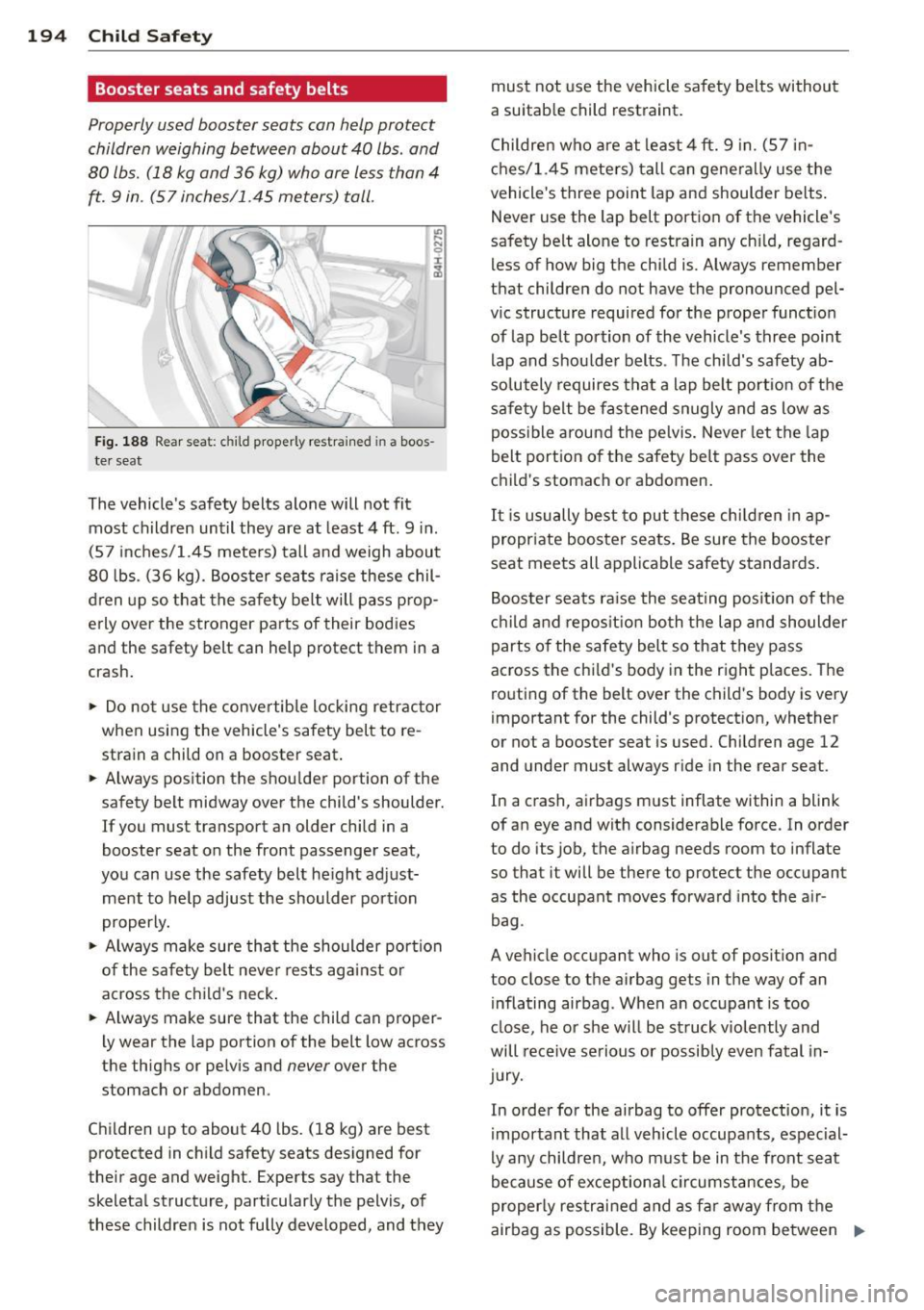
194 Child Safety
Booster seats and safety belts
Properly used booster seats can help protect
children weighing between about 40 lbs. and
80 lbs. (18 kg and 36 kg) who are less than 4
ft. 9 in. (57 inches/1.45 meters) tall.
Fig. 188 Rear seat: child properly restrained in a boos
ter seat
The vehicle's safety belts alone will not fit
most children until they are at least 4
ft. 9 in.
(57 inches/1.45 meters) tall and weigh about
80 lbs . (36 kg). Booster seats raise these chil
dren up so that the safety belt will pass prop
erly over the stronger pa rts of their bodies
and the safety belt can help protect them in a
crash.
.. Do not use the convertible locking retractor
when using the vehicle's safety belt to re
strain a chi ld on a booster seat .
.. Always position the shou lder portion of the
safety belt midway over the child's shoulder.
If you must transport an older child in a
booster seat on the front passenger seat,
you can use the safety belt he ight adjust
ment to help adjust the shoulder portion
properly .
.. Always make sure that the shoulder portion
of the safety belt never rests against or
across the child's neck .
.. Always make sure that the child can proper
ly wear the lap portion of the belt low across
the thighs or pe lvis and
never over the
stomach or abdomen.
Children up to about 40 lbs. (18 kg) are best
protected in ch ild safety seats designed for
the ir age and weight. Experts say that the
skeletal structure, particularly the pelvis, of
these children is not fully developed, and they must not
use the vehicle safety belts without
a suitab le child restraint.
Children who are at least 4
ft. 9 in. (57 in
ches/1.45 meters) tall can generally use the
vehicle's three point lap and shoulder belts .
Never use the lap belt portio n of the vehicle 's
safety belt alone to restrain any child, regard
less of how big the chi ld is. Always remember
that children do not have the pronounced pel
vic structure required for the proper function
of lap belt portion of the vehicle 's three point
lap and shoulder belts . The child's safety ab
solutely requires that a lap belt port ion of the
safety belt be fastened snugly and as low as
possible around the pelvis. Never let the lap
belt portion of the safety belt pass over the
c hild' s stomach or abdomen.
It is usually best to put these children in ap
propriate booster seats. Be sure the booster
seat meets all applicable safety standards.
Booster seats raise the seating position of the
child and reposition both the lap and shoulder
parts of the safety belt so that they pass
across the child's body in the right p laces. The
routing of the belt over the child's body is very
i mportant for the child's protect ion, whether
or not a booster seat is used. Children age 12
and under must always ride in the rear seat .
In a crash, airbags must inflate within a blink
of an eye and with considerable force. In order
to do its job, the airbag needs room to inflate
so that it will be there to protect the occupant
as the occupant moves forward into the air
bag.
A vehicle occ upant who is out of posit ion and
too close to the airbag gets in the way of an inflating airbag. When an occupant is too
close, he or she will be struck violently and
will receive serious or possibly even fatal in
Jury.
In order for the airbag to offer protection, it is
important that all vehicle occupants, especial-
ly any children, who m ust be in the front s eat
because of exceptiona l circumstances, be
properly restrained and as far away from the
airbag as possible. By keeping room between ..,_
Page 197 of 316
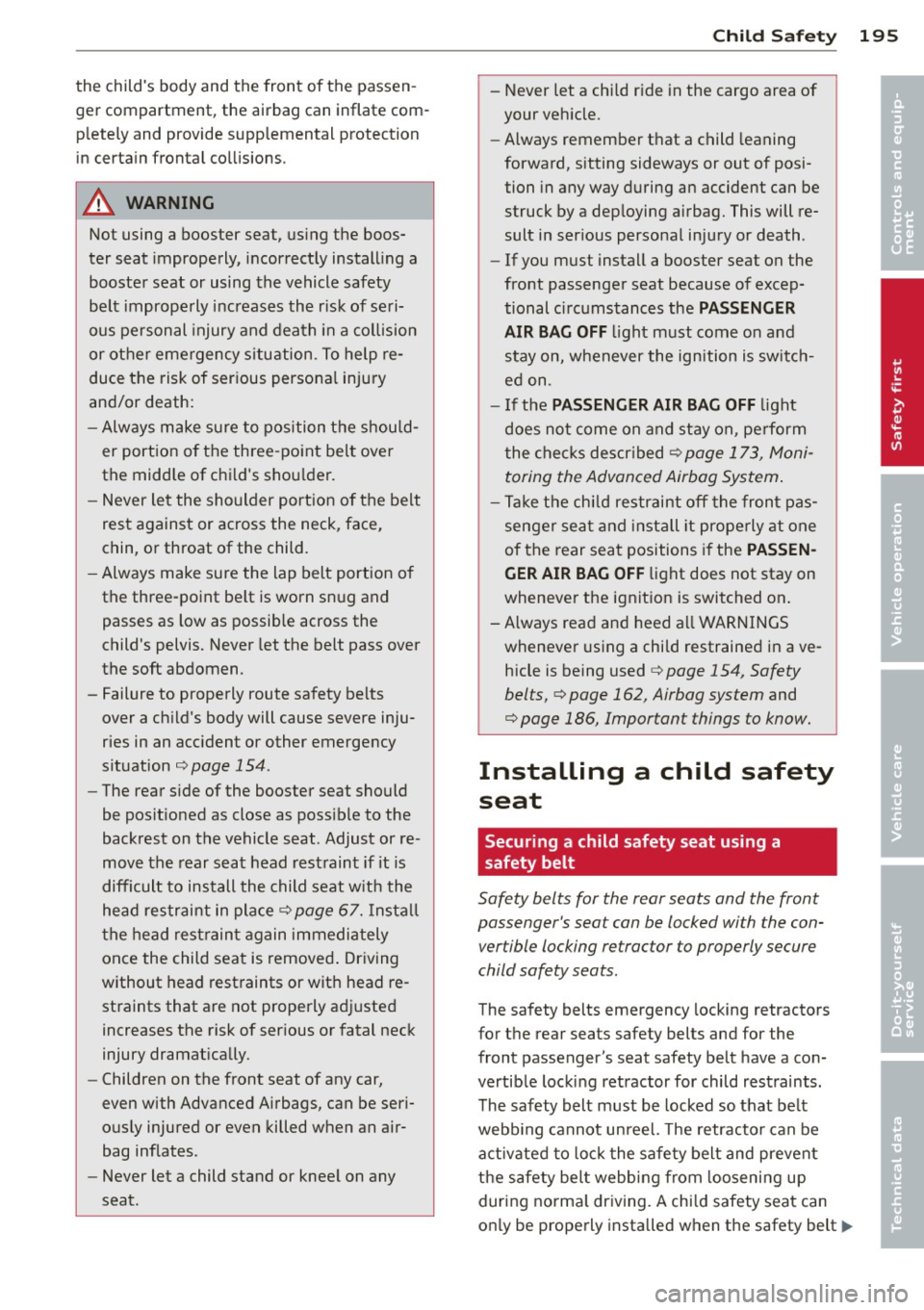
the child's body and the front of the passen
ger compartment, the airbag can inflat e com
p letely and provide supplemental protection
in certa in frontal col lisions .
_&. WARNING
Not using a booster seat, us ing the boos
ter seat improperly, incorrect ly installing a
booster seat or using the vehicle safety
belt improperly increases the risk of seri
ous personal injury and death in a collision
or ot her eme rgency s ituation. To help re
duce t he risk of ser ious persona l injury
and/or death:
- Always make sure to position the should
er port ion of the three -po int bel t over
the middle of chi ld's sho ulder.
- Never let the shoulder port ion of the be lt
rest against or across the neck , face,
chin, or throat of the child .
- Always make sure the lap belt portion o f
the three-po int be lt is worn sn ug and
passes as low as possib le across the
child's pelvis. Never let the belt pass over
the soft abdomen.
- Failure to properly route sa fety belts
over a ch ild's body will cause severe inju
ries in an acc ident or other emergency
situation
¢page 154.
-The rear s ide of the booster seat should
be pos it ioned as close as poss ible to the
backrest on the vehicle seat . Adjust or re
move the rear seat head rest raint if it is
difficult to install the child seat w it h the
head restraint in place¢
page 67. Insta ll
the head res train t again immedia tely
once the child seat is removed . Dr iving
without head rest raints or with head re
straints that are not properly adj usted
increases the risk of ser ious o r fatal neck
injury dramat ically.
- Children on the front seat of any car,
even with Advanced A irbags, can be seri
o usly injured or even killed when an a ir
bag inf lates.
- Never let a child stand or knee l on any
seat.
Child Sa fet y 195
-Never let a chi ld r ide in the cargo area of
your veh icle.
- Always remembe r th at a c hild leaning
forward, sitting sideways or out of posi
tion in any way d uring an accident can be
struck by a dep loying a irbag. This will re
sult in ser ious personal inju ry or death .
- If you must install a booster seat on the
front passenger seat because of excep
tional ci rcumstances the
PASSENGER
AIR BAG OFF
li ght m ust come o n and
s tay on, whenever the ignition is switch
ed on .
- I f the
PASSENGER AIR BAG OFF light
does not come on and stay on, pe rform
the c heck s descr ibed
¢ page 173, Moni
toring the Advanced Airbag System .
- Take the chi ld restraint off the fron t pas
senger sea t and inst all it prope rly at one
of the rear sea t positions if the
PASSEN
GER AIR BAG OFF
li ght does not stay on
whenever the ignit ion is switched on .
-A lways read an d heed a ll WAR NIN GS
wheneve r us ing a chi ld restrained in ave
hicle is being used
¢ page 154, Safety
belts,
¢ page 162, Airbag system and
¢ page 186, Important things to know.
Installing a child safety
seat
Securing a child safety seat using a
safety belt
Safety belts for the rear seats and the front
passenger's sea t con be locked w ith the con
ver tible locking re tractor to properly secure
child safety seats .
The safety belts emergency locking ret ractors
for the rear seats safety bel ts and for the
front passenger's seat safety be lt have a co n
vertib le locking retractor for child rest raints.
T he safety belt must be locked so that be lt
webb ing cannot unreel. The retractor can be
activated to lo ck the safe ty belt and prevent
t h e safety be lt webbing from looseni ng up
during norma l dr iving . A chi ld safety seat can
o nl y be properly installed when the safety belt...,
•
•
Page 198 of 316
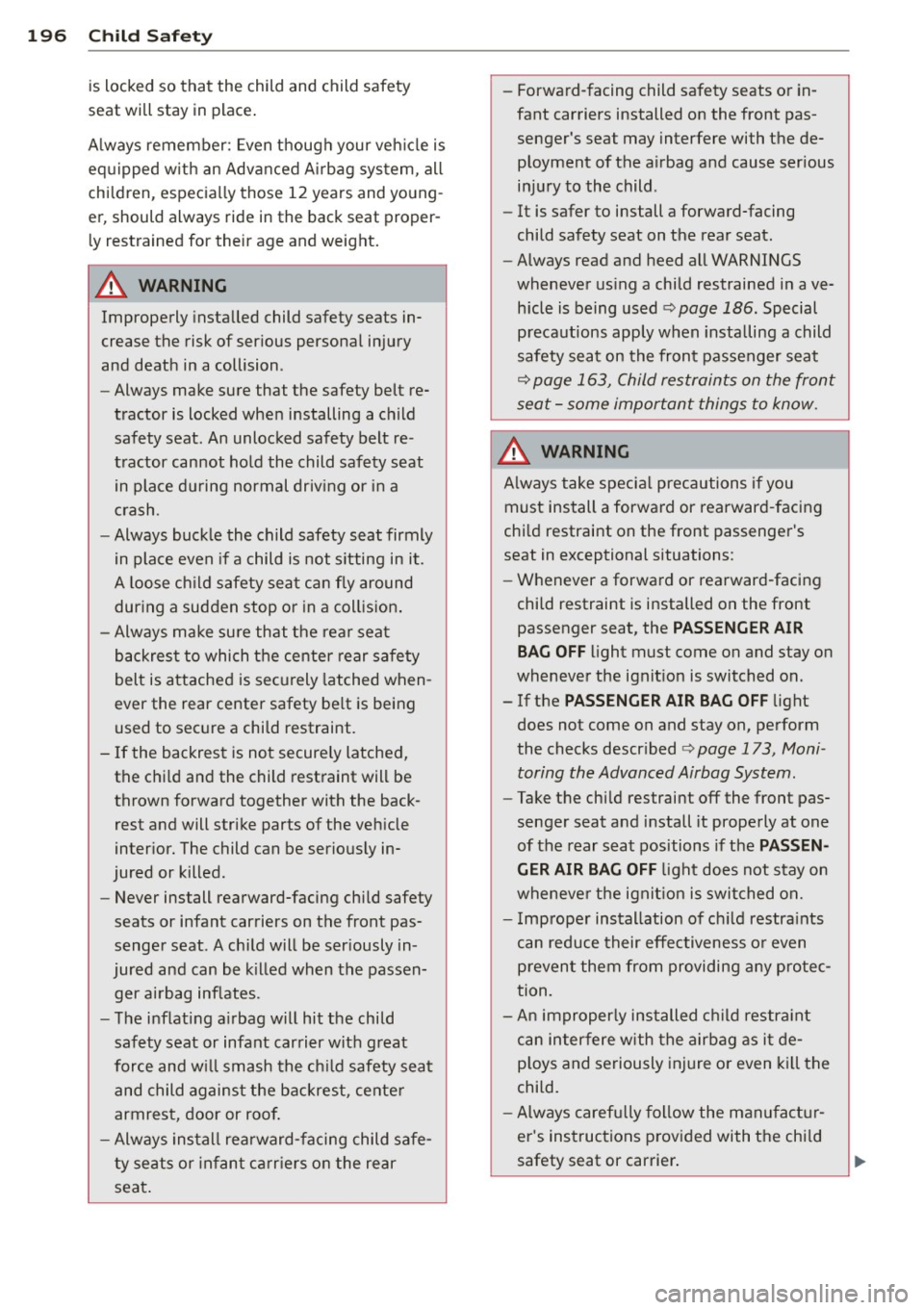
196 Child Safety
is locked so that the child and child safety
seat will stay in place.
Always remember: Even though your vehicle is
equipped with an Advanced Airbag system, all
children, especially those 12 years and young
er, should always ride in the back seat proper ly restrained fo r their age and weight.
.&_ WARNING
Improperly installed child safety seats in
crease the risk of serious personal injury
and death in a collision.
- Always make sure that the safety belt re
tractor is locked when installing a child
safety seat . An unlocked safety belt re
tractor cannot hold the child safety seat in place during normal driving or in a
crash .
- Always buckle the child safety seat firmly
in place even if a child is not sitting in it.
A loose child safety seat can fly around
during a sudden stop or in a collision.
- Always make sure that the rear seat
backrest to which the center rear safety
belt is attached is securely latched when
ever the rear center safety belt is being
used to secure a child restraint.
- If the backrest is not securely latched, the child and the child restraint will be
thrown forward together with the back
rest and will strike parts of the vehicle
interior. The child can be seriously in
jured or killed.
- Never install rearward-facing child safety
seats or infant carriers on the front pas
senger seat . A child will be seriously in
jured and can be killed when the passen
ger airbag inflates.
- The inflating airbag will hit the child
safety seat or infant carrier with great
force and will smash the child safety seat
and child against the backrest, center
armrest, door or roof.
- Always install rearward-facing child safe
ty seats or infant carriers on the rear
seat. -
Forward-facing child safety seats or in
fant carriers installed on the front pas
senger 's seat may interfere with the de
ployment of the airbag and cause serious
injury to the child .
- It is safer to install a forward-facing
child safety seat on the rear seat.
- Always read and heed all WARNINGS
whenever using a child restrained in ave
hicle is being used
~ page 186. Special
precautions apply when installing a child
safety seat on the front passenger seat
~ page 163, Child restraints on the front
seat -some important things to know.
.&_ WARNING
-
Always take special precautions if you
must install a forward or rearward-facing
child restraint on the front passenger's
seat in exceptional situations:
- Whenever a forward or rearward-facing
child restraint is installed on the front
passenger seat, the
PASSENGER AIR
BAG OFF light must come on and stay on
whenever the ignition is switched on.
- If the
PASSENGER AIR BAG OFF light
does not come on and stay on, perform
the checks described
~ page 173, Moni
toring the Advanced Airbag System.
- Take the child restraint off the front pas
senger seat and install it properly at one
of the rear seat positions if the
PASSEN
GER AIR BAG OFF
light does not stay on
whenever the ignition is switched on.
- Improper installation of child restraints
can reduce their effectiveness or even
prevent them from providing any protec
tion.
- An improperly installed child restraint
can interfere with the airbag as it de
ploys and seriously injure or even kill the
child.
- Always carefully follow the manufactur
er's instructions provided with the child
safety seat or carrier.
Page 199 of 316
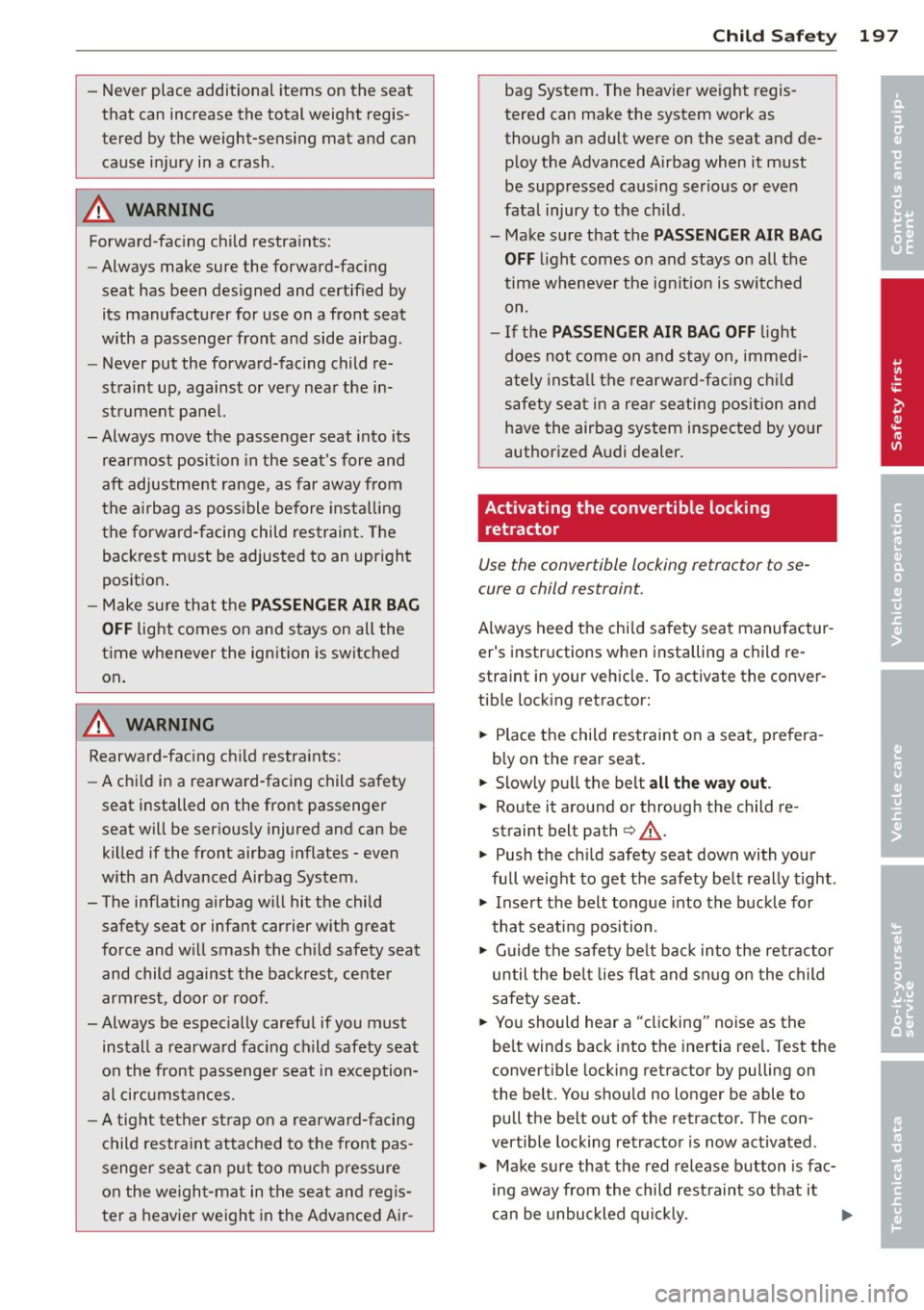
-Never place additional items on the seat
that can increase the total weight regis
tered by the weight-sensing mat and can
cause injury in a crash .
_&. WARNING
Forward-facing child restraints:
- Always make sure the forward-facing
seat has been designed and certified by
its manufacturer for use on a front seat
with a passenger front and side airbag .
- Never put the forward-facing child re
straint up, against or very near the in
strument panel.
-Always move the passenger seat into its
rearmost position in the seat's fore and
aft adjustment range, as far away from
the airbag as possible before installing
the forward-facing child restraint. The
backrest must be adjusted to an upright
position.
- Make sure that the
PASSENGER AIR BAG
OFF
light comes on and stays on all the
time whenever the ignition is switched
on.
_&. WARNING
Rearward-facing child restraints:
- A child in a rearward-facing child safety
seat installed on the front passenger
seat will be seriously injured and can be
killed if the front airbag inflates -even
with an Advanced Airbag System.
- The inflating airbag will hit the child
safety seat or infant carrier with great
force and will smash the child safety seat
and child against the backrest, center
armrest, door or roof.
- Always be especially careful if you must
install a rearward facing child safety seat
on the front passenger seat in exception
al circumstances.
-A tight tether strap on a rearward-facing
child restraint attached to the front pas
senger seat can put too much pressure
on the weight-mat in the seat and regis
ter a heavier weight in the Advanced Air-
Child Safety 197
bag System. The heavier weight regis
tered can make the system work as
though an adult were on the seat and de ploy the Advanced Airbag when it must
be suppressed causing serious or even
fatal injury to the child.
- Make sure that the
PASSENGER AIR BAG
OFF
light comes on and stays on all the
time whenever the ignition is switched
on .
- If the
PASSENGER AIR BAG OFF light
does not come on and stay on, immedi
ately install the rearward-facing child
safety seat in a rear seating position and
have the airbag system inspected by your
authorized Audi dealer.
Activating the convertible locking
retractor
Use the convertible locking retractor to se
cure a child restraint.
Always heed the child safety seat manufactur er 's instructions when installing a child re
straint in your vehicle. To activate the conver
tible locking retractor:
.. Place the child restraint on a seat, prefera
bly on the rear seat.
.. Slowly pull the belt
all the way out.
.. Route it around or through the child re
straint belt path
c:> ,&. .
.. Push the child safety seat down with your
full weight to get the safety belt really tight.
.. Insert the belt tongue into the buckle for
that seating position .
.. Guide the safety belt back into the retractor
until the belt lies flat and snug on the child
safety seat.
.. You should hear a "clicking" noise as the
belt winds back into the inertia reel. Test the
convertible locking retractor by pulling on
the belt. You should no longer be able to
pull the belt out of the retractor. The con
vertible locking retractor is now activated .
.. Make sure that the red release button is fac
ing away from the child restraint so that it
can be unbuckled quickly. .,. •
•
Page 200 of 316
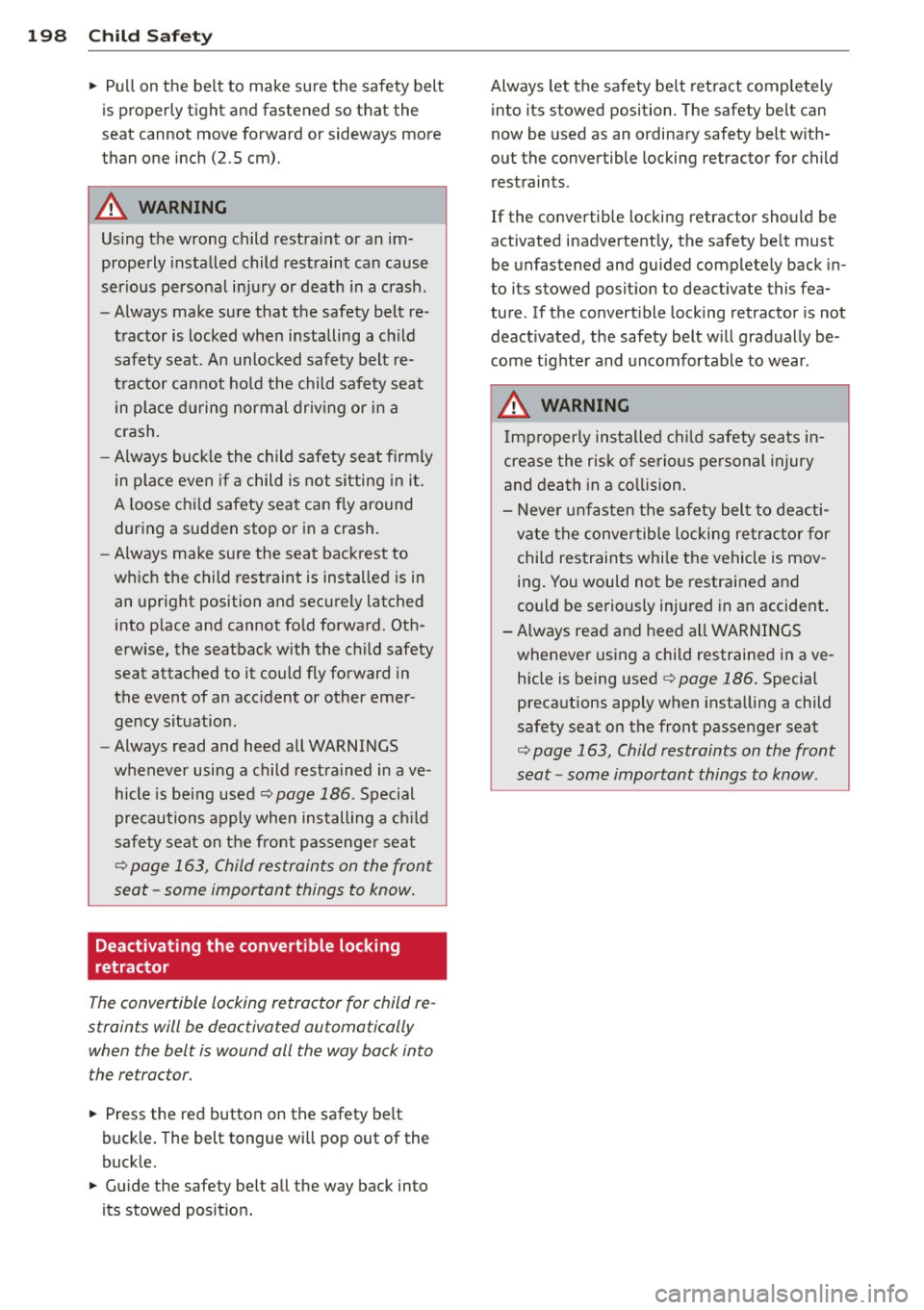
198 Child Saf ety
• Pull on the be lt to make sure the safety belt
is properly tight and fastened so that the
seat cannot move forward or sideways more
than one inch (2.5 cm).
A WARNING t ...cc= -
Using the wrong child restraint or an im-
properly installed child rest raint can cause
ser ious personal in ju ry or death in a crash.
- Always make sure that the safety belt re-
tractor is locked whe n installing a child
safety seat . An unlocked safety belt re
t ra ctor cannot ho ld the child safety seat
in place during norm al driv ing or in a
c rash.
- Always buc kle the child s afety seat firmly
in place even if a child i s not s itting in i t.
A loose ch ild safety seat can fly around
during a sudden stop or in a crash.
- Always make su re the seat bac krest to
which the c hild restraint is installed is in
an upright position and sec urely latched
into p lace and cannot fo ld forward. Oth
erwise, the seatback w ith the child safety
seat attached to it could fly forward in
the event of an acc ident or other emer
gency situation .
- Always read and heed all WARNINGS
whenever using a child rest rained in ave
hicle is being used
c::> page 186. Special
precautions apply when i nstalling a ch ild
safety seat on the front pas senge r seat
c::> page 163, Child restraints on the front
seat -some important things to know.
Deactivating the convertible locking
retractor
The convertible locking retractor for child re
straints will be deactivated automatically
when the belt is wound all the way back into the retractor.
• Press the red button on the safety be lt
buck le . The belt tongue wi ll pop out of the
buck le.
• Gu ide t he safety belt all the way back into
its stowed pos it io n. Always
let the safety be lt ret ract completely
into its stowed position. The safety be lt can
now be used as an ordina ry safety belt w ith
out the convertible locking retracto r for child
restraints.
If the conver tible locking retractor should be
activated inadvertent ly, the safety be lt must
be unfastened and guided complete ly back in
to its stowed posit ion to deactivate this fea
ture. If the convert ible locking retractor is not
deact ivated, the safety belt w ill gradually be
come tig hte r and uncomfortable to wear.
A WARNING
Imp ro perly in stalled ch ild safety seats in
crease the risk of serious pe rsonal injury
and death in a co llision.
- Never u nfasten the safety belt to deacti
v ate the conve rtible locki ng re tra cto r f or
chi ld res traints whi le the vehicle is mov
ing . You would not be restrained and
could be seriously in ju red in an accident .
- Always rea d and heed a ll WAR NIN GS
wheneve r using a child res traine d in ave
hicle is being used c::> page 186. Special
precautions apply when insta lling a child
safety seat on the front passenger seat
c::> page 163, Child restraints on the front
seat -some important things to know .